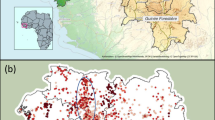Abstract
The great need for adequate documentation of germplasm collections, including accurate geographic location, needs again to be stressed. We discuss 3 reported stations for teosinte (Zea spp., Gramineae) in Guatemala. The first was discovered by Melhus and Chamberlain in 1949; an attempt by the senior author to relocate this station in 1976 was unsuccessful, but we now have a good idea of where this population (probablyZ. luxurians) may occur. The second, that of Rojas in 1942, lies well outside the known ranges of either of the 2 Guatemalan teosintes, Z.luxurians andZ. mays subsp.parviglumis var.huehuetenangensis. The third, a collection of Steyermark’s, turns out to be aTripsacum. We urge plant scientists, applied botanists, geographers, anthropologists, and others to provide voucher specimens with accurate location data for all plant populations that they study.
Similar content being viewed by others
Literature Cited
Brenan, J. P. M. 1973. The value of herbaria for cultivated plants.In P. S. Green, ed, Plants: Wild and Cultivated, p. 38–47. Classey, Middlesex.
Bunting, A. H., and H. Kuckuck. 1970. Ecological and agronomic studies related to plant exploration.In O. Frankel and E. Bennett, ed, Genetic Resources in Plants-Their Exploration and Conservation. Int. Biol. Programme Handbook No. 11, p. 181–188. Davis, Philadelphia.
Collins, G. N. 1932. The rediscovery of teosinte in Guatemala. J. Heredity 23: 260–265.
Doebley, J. F., and H. H. Iltis. 1980. Taxonomy ofZea (Gramineae). I. A subgeneric classification with key to taxa. Amer. J. Bot. 67: 982–993.
Fosberg, F. R. 1950. Remarks on the factual basis of ecology. Ecology 31: 653–654.
Guzman, M. R. 1978a. Redescubrimiento deZea perennis (Gramineae). Phytologia 38: 177.
—. 1978b. Una nueva localidad para el teosinteZea perennis y primer reporte deZea mexicana para Jalisco. Bol. Inform. Inst. Bot., Univ. Guadalajara 6: 9–10.
—. 1982. El teosinte en Jalisco: Su distribucion y ecología. Tésis, Univ. Guadalajara.
Hoshaw, R. W. 1983. Systematics of the Zygnemataceae (Chlorophyceae). III. Transeau collection of the Zygnemataceae: An old collection with modem uses. Amer. J. Bot. 70: 145–153.
Holden C., 1985. New directions for the Smithsonian. Science 228: 1512–1513.
Hyland, H. L. 1970. Description and evaluation of wild and primitive introduced plants.In O. Frankel and E. Bennett, ed, Genetic Resources in Plants-Their Exploration and Conservation. Int. Biol. Programme Handbook No. 11, p. 413–420. Davis, Philadelphia.
Iltis, H. H., and J. F. Doebley. 1980. Taxonomy ofZea (Gramineae). II. Subspecific categories in theZea mays complex and a generic synopsis. Amer. J. Bot. 67: 994–1004.
—, and —. 1984.Zea-A. biosystematical Odyssey.In W. Grant, ed, Plant Biosystematics, p. 587–616. Academic Press, Canada.
—, —, R. Guzman M., and B. Pazy. 1979.Zea diploperennis (Gramineae): A new teosinte from Mexico. Science 203: 186–188.
—-, and W. M. Shaughnessy. 1960. Preliminary reports on the flora of Wisconsin. No. 43. Primulaceae-primrose family. Trans. Wisconsin Acad. Sei. 49: 113–135.
Melhus, I. E., and I. M. Chamberlain. 1953. A preliminary study of teosinte in its region of origin. Iowa St. Coll. J. Sei. 28: 139–164.
Price, D. J. de S. 1963. Little Science, Big Science. Columbia Univ. Press, New York.
Rojas, U. 1942. Hibridaciones sobre “Euchlaena mejicana” [sic] Schrad. Flora (Quito, Ecuador) 2: 55–65.
Sauer, J. D. 1953. Herbarium specimens as records of genetic research. Amer. Naturalist 87: 155–156.
Stafleu, F.A. et al., ed. 1978. International Code of Botanical Nomenclature Adopted by the Twelfth International Botanical Congress, Leningrad, July 1975. Bonn, Scheltema and Holkema, Utrecht.
Weatherwax, P. 1935. The phylogeny ofZea mays. Amer. Midi. Naturalist 16: 1–71.
Wilkes, H. G. 1967. Teosinte: The closest relative of maize. Bussey Inst., Harvard Univ., Cambridge, MA.
—. 1977. Hybridization of maize and teosinte, in Mexico and Guatemala and the improvement of maize. Econ. Bot. 31: 254–293.
Author information
Authors and Affiliations
Rights and permissions
About this article
Cite this article
Iltis, H.H., Kolterman, D.A. & Benz, B.F. Accurate documentation of Germplasm: The lost guatemalan teosintes (Zea, Gramineae). Econ Bot 40, 69–77 (1986). https://doi.org/10.1007/BF02858948
Received:
Revised:
Accepted:
Issue Date:
DOI: https://doi.org/10.1007/BF02858948




